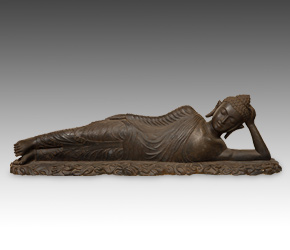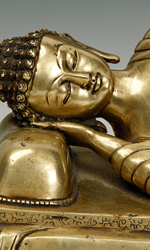 |
|
"Buddhism in Southeast Asia adhered to the Mahayana doctrine and depictions of Buddha attempted to convey a single, simple truth conveyed in the hand positions (mudras), leg positions (asanas), and serene, knowing faces. The life of Buddha is generally broken down into what are called the twelve deeds; the twelfth and final deed depicts Buddha entering nirvana"
To fully appreciate depictions of the Buddha, we must first address the story of his life. The original Buddha, Sakyamuni Gautama, or Gautama Siddhartha, was born in India in the 5th-6th century B.C. He was born into a noble family, but left this life to lead the life of a wandering ascetic and thinker. Reflecting on the human condition one night while sitting under a Bodi tree, he awoke to find he had realized a state of absolute beatitude, and would not be reborn again. In other words, he had gained a complete state of liberation from worldly attachment. He spent the rest of his life as a preacher, his teachings contained in a series of documents called the Sutras.
 |
|
As time passed, Buddhism adapted to new cultures. At the beginning of the first century A.D. Buddhist doctrine underwent a change from a simple philosophy of life into a set of religious doctrines with the Buddha transformed into a deity on the same level as Hindu gods. It is thought, however, that Buddha never projected himself as a divine entity or master, demanding from his followers only personal attainment through meditation and reflection, the object being to liberate oneself from the cycle of rebirths to reach the heavenly state of nirvana.
At the beginning of the Christian era certain Buddhist monks annexed a pantheon of deities from Hinduism (deities the Buddha himself did not deny) and the sutra were enriched with innumerable texts of explanation. However, a few monks rejected these new texts and insisted on the scriptures to the letter. Thus, two great schools of Buddhism were born: the first faithful to the teachings of the original Buddha and the second composed of various philosophies applied to the Buddha’s teachings. These schools became known as the Hinayana (small vehicle) and the Mahayana (great vehicle), paths which both lead to nirvana.
 |
 |
Buddhist missionaries brought their doctrines very early to Asian countries. Ultimately, the effigies representing the Buddha assumed a local character, and the faces of the deities became influenced by local ethnic types and the aesthetic canons of the regions. In Burma and parts of Thailand on the Thai/Burma border, the heads of the Buddhas shortened, the nose straightened, and the “attitudes” became more relaxed. Buddhism in Southeast Asia adhered to the Mahayana doctrine and depictions of Buddha attempted to convey a single, simple truth conveyed in the hand positions (mudras), leg positions (asanas), and serene, knowing faces.
 |
The life of Buddha is generally broken down into what are called the twelve deeds.
First Deed: Descending from Tushita Heaven
The Buddha descended from a realm called Tushita heaven. This is the realm where the Devas (gods) reside. He came to teach the dharma. The first deed of leaving Tushita to be born was intended to teach that somebody who has achieved enlightenment is no longer a slave of his own karma and has control over anything he or she does. So the Buddha chose to take birth to teach this lesson.
Second Deed: Entering the Mother’s Womb
The Buddha was conceived into the womb of his mother, Mayadevi, during a dream where he was disguised as a white elephant. This was done to instill conviction and confidence in his future disciples.
Third Deed: Taking Birth
The Buddha came out of the body of his mother from under her right arm, not her womb. At the time of his birth, crops started growing, trees appeared, and rare flowers started blooming. Due to these events, from that moment onwards, he was given the name Siddhartha in Sanskrit, or Tungye Drup in Tibetan, which means, “the one that makes everything possible.”
Fourth Deed: Accomplishment in the Worldly Arts
As Buddha grew up, he was educated and became very knowledgeable, scholarly, and skillful. He did this to show that it is important to be part of the positive aspects of culture in order to properly transmit the dharma, or Buddhist teachings.
Fifth Deed: Marriage and the Four Excursions
In this deed or phase of his life, Buddha married and left his compound four times. The royal palace where he lived was enclosed with high walls and four gates facing each of the cardinal points. Each time he left the palace, he learned a different life lesson. The first time he went out through the eastern gate of the palace and saw the suffering of an old man, discovering that all persons experience degeneration of the body. The second time he left through the southern gate and saw a sick person, discovering the suffering that all persons at one time or another endure. The third time he went out through the western gate and saw a dead person, discovering that all persons must undergo death. The first three lessons illustrated that no one can defeat these types of suffering. No one can fight and defeat these three kinds of suffering. The fourth time he left the palace through the northern gate and saw a begging monk, and he discovered the pursuit of a spiritual path can allow us to liberate ourselves from unpleasant physical reality.
 |
|
Sixth Deed: Renunciation
At the age of 29, Buddha left his royal life in search of a true spiritual path. He led the life of a wandering ascetic and thinker.
Seventh Deed: Life as an Ascetic
Buddha led an austere life for six years. This showed future disciples that with a great amount of effort, perseverance and diligence, enlightenment could be achieved. He gave up all his austerities when he accepted a bowl of yogurt. In turn, this showed future devotees that the main object of Buddhist practice is working with one’s mind. By eliminating negativity and working to nourish positive qualities such as knowledge and understanding, enlightenment could be attained.
Eighth Deed: Enlightenment Under the Bodhi Tree
After giving up ascetic practice, Buddha vowed to stay under a bodhi tree until he reached final awakening. This demonstrated that true practice lies in the middle of the two extremes: practicing too many austerities and being too indulgent. This is called the middle path.
Ninth Deed: The Conquest of Evils
Under the bodhi tree, Buddha battled three disturbing emotions – ignorance, desire, and aggression. He remained immersed in compassion and loving-kindness and was able to eventually achieve enlightenment.
Tenth Deed: Attainment of Buddhahood
In finally attaining an enlightened state, Buddha demonstrated that “Buddhahood” is something we can achieve by looking inside ourselves. In the same way he reached enlightenment, we also can achieve enlightenment. He illustrated that by eliminating all negative emotions, enlightenment is attainable
Eleventh Deed: Promulgating the Teachings
Buddha taught the possibility of happiness or reaching liberation is entirely up to us. If we practice the path that leads to liberation, we will attain Buddhahood. The choice is ours. Ultimately, his disciples, known as Lohans, wrote down his teachings in a series of books called sutras.
Twelfth Deed: Entering Nirvana
Buddha passed at the age of 83. He asked his students if they had any final questions and then lying on his side, in the lion’s posture, he entered nirvana, a complete state of rest and liberation. His last words were, “Never forget, decay is inherent in all composite things. Therefore, work diligently.”
